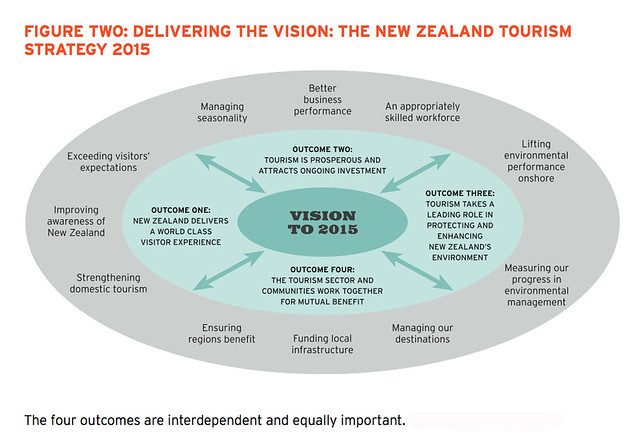いわば、NZ版「ビジットおきなわ計画」?…しかし、これは2015年までの長期計画を2007年に当時のヘレン・クラーク首相が発表したものなので、どちらかというとNZ版「沖縄振興計画」?…に近いかもしれません。まあ、足して2で割ったようなものです…
2007年発表というと、世界的な経済にもいろいろな変化がありましたので、いささか古い印象を受けますが、しかしNZの観光政策におけるこの大切な柱は、今もほとんどブレずに中心的な理念となっています。それぞれの理念は時代の変化に左右されるようなものではありませんし、そこから派生する細かい戦略は、膨大で多岐にわたっています。まさに今、NZ観光はこの理念に沿って実行されている印象を受けます。
その計画とは
NEW ZEALAND TOURISM STRATEGY 2015
 |
| photo:http://www.nztourismstrategy.com/ |
さて、この計画の中では何がうたわれているのかというと
まず、目指すべき将来ビジョンとしては
2015年に観光業は、NZの持続可能経済のリーディング産業になる
そして、計画の中でキーとなる価値観として、二つのマオリの言葉をあげています。
それは kaitiakitanga と manaakitanga です。
一方、Manaakitangaは「ホスピタリティー」です。
将来ビジョンとキーフレーズを紹介しましたが、この計画では、資料上ではまず冒頭、現在のNZにおける観光産業の経済的な位置づけと、環境保護の重要性についてページを割いています。
NZの観光産業の規模や位置づけはこのブログの冒頭でも投稿しましたが、GDPの約10%を占めています。2010年の国際観光客数は250万人。この計画が発表されたのは2007年ですが、2020年までに毎年4.1%の成長を続けると予測しています。
そして観光業を輸出セクターの一つと捉え、売っているのはNZの人、場所、ワイン、体験、つまりNZ自身だとしています。
また、環境保護の大切さについて説明する章では、まさに観光業の商品がNZ自身である限り、将来の世代に引き渡すためにも、環境保護が重要であるとしています。
 |
| photo:http://www.nztourismstrategy.com/ |
さて、ではその具体的な戦略ですが、計画では大きな4つの目標を掲げ、それぞれの目的達成のための具体的な戦略が詳述されています。
その4つの目標とは
1. NZは世界クラスのビジター体験を提供します。
2. NZの観光業は経済的にも成功し、投資を呼び込みます。
3. 観光業は、自然環境を守り、その環境をさらに高めるため、中心的役割を果たします。
4. 観光業は地域と連携して、お互いの利益のために働きます。
となっています。
正確な原文は投稿の最後に添付してありますので、参考にしてください。
正確な原文は投稿の最後に添付してありますので、参考にしてください。
目標の1や2などは、詳細を見ていくとさらに面白いです。この4つの目標の詳細は最後に添付しました。
一方、計画3のように、やはりNZでは、しつこいほどに環境保護をその基本理念の中で確認しているところに特徴があるように感じます。計画全体を統括する理念として環境保護を掲げていて、さらに具体的な目標、戦略にも細かく環境を守るための計画を明確化しているところはNZらしいところです。当然,観光業だけでなく、国内のあらゆる経済活動も、この観光を支える、自然保護の戦略を実行するため、自然環境を無視してはできないことになります。
NZ観光局では、この計画に沿った様々な戦略の進行状況を毎年確認しています。もちろん、最新のデータや動向も分析、HPで公開(Tourism New Zealand)していて、それに応じたマーケティング戦略も実行しているようです。特に急激に伸びている中国人観光客に対する戦略はあらためてご紹介したいと思います。
いずれもHPで、非常に分かりやすく公開しています。
それが、なによりもすごいと思うところですね。
 |
From:Tourism New Zealand
|
以下、4つの目標の詳細
OUTCOME ONE
NEW ZEALAND DELIVERS A WORLD–CLASS VISITOR EXPERIENCE
NEW ZEALAND DELIVERS A WORLD–CLASS VISITOR EXPERIENCE
- New Zealand is seen by visitors as a desirable, high–quality destination
- The New Zealand tourism industry offers booking services that are easy to use
- The i–SITE network is recognised by visitors as being a source of high–quality and objective visitor information
- Qualmark is recognised by consumers as a mark of quality
- The tourism sector is committed to monitoring visitor satisfaction and perceptions of quality
- New Zealand’s infrastructure supports a quality visitor experience at all stages of the journey
- Domestic travellers help create a strong demand for visitor products and services
- Maori actively participate and invest in the tourism sector.
OUTCOME TWO
NEW ZEALAND’S TOURISM SECTOR IS PROSPEROUS AND ATTRACTS ONGOING INVESTMENT
NEW ZEALAND’S TOURISM SECTOR IS PROSPEROUS AND ATTRACTS ONGOING INVESTMENT
- Tourism businesses identify and put in place strategies that will consistently increase their returns on investment
- Businesses deliver products and experiences that meet the expectations of high–value visitors
- Tourism attracts and retains an appropriately skilled workforce
- The tourism sector improves demand during the off–season
- New Zealand’s tourism research is accessible, timely, high–quality, and relevant to the decisions that need to be made.
OUTCOME THREE
THE TOURISM SECTOR TAKES A LEADING ROLE IN PROTECTING AND ENHANCING THE ENVIRONMENT
THE TOURISM SECTOR TAKES A LEADING ROLE IN PROTECTING AND ENHANCING THE ENVIRONMENT
- The tourism sector contributes to a whole–of–New Zealand approach to ensure that New Zealand’s environment will continue to be enjoyed by future generations and visitors, in the spirit of kaitiakitanga (guardianship)
- The expectations of our visitors are clearly understood, and visitors are able to easily identify and select products that deliver good environmental performance
- The tourism sector leads the way in introducing initiatives that will reduce carbon emissions and increase the energy efficiency of transport within and en route to New Zealand
- The tourism sector improves its energy efficiency, energy conservation, and use of renewable
energy at all levels - The tourism sector takes active steps to reduce and manage its waste, encourages other sectors to do the same, and engages with the local, regional, and national agencies that provide waste–management standards and facilities
- Tourism businesses have the capability and knowledge to take a leading role in protecting and enhancing the environment
- The tourism sector, DOC, and other key agencies continue to work together to make sure that conservation values are enhanced
- Visitors’ tourism experiences give them the opportunity to learn about and contribute to New Zealand’s environmental and conservation goals.
OUTCOME FOUR
THE TOURISM SECTOR AND COMMUNITIES WORK TOGETHER FOR MUTUAL BENEFIT
THE TOURISM SECTOR AND COMMUNITIES WORK TOGETHER FOR MUTUAL BENEFIT
- The tourism sector is an active partner in planning and managing our communities
- Local authorities understand the benefits tourism offers and lead destination management and planning initiatives and processes to maximise these benefits
- Tourism decision–making by local government, communities, iwi, and the tourism sector is
informed by high–quality research - Regions and communities preserve and promote their local culture and character and incorporate this into all aspects of the visitor experience
- Core infrastructure and facilities are appropriately funded.


0 件のコメント:
コメントを投稿